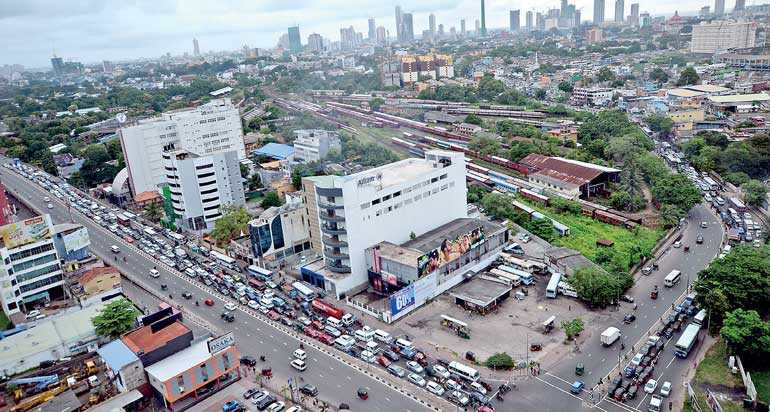Monday Jan 05, 2026
Monday Jan 05, 2026
Tuesday, 16 February 2021 01:09 - - {{hitsCtrl.values.hits}}

The vehicle import ban, which was a temporary fix, a plaster on a broken leg, it seems, has done what it intended to do. It shocked the country, ruffled the feathers of what’s possible, pushed boundaries, questioned norms and challenged the status quo. It opened minds, paved a path and stands today as a bridge between what was, and what is to come. And that is the question of the hour. What is to come? – Pic by Shehan Gunasekara
 The COVID-19 pandemic has changed the landscape of the world forever. Amidst such unprecedented trials, Sri Lanka has also been tasked with the economic challenge of preserving her foreign reserves. Where did all this lead? To the indefinite import ban on all non-essential goods, including, motor vehicles, earlier this year.
The COVID-19 pandemic has changed the landscape of the world forever. Amidst such unprecedented trials, Sri Lanka has also been tasked with the economic challenge of preserving her foreign reserves. Where did all this lead? To the indefinite import ban on all non-essential goods, including, motor vehicles, earlier this year.
Since March 2020, the import ban, which was initially supposed to last only three months, has lasted 10 months, and counting. The distant horizon doesn’t seem to show signs of relief either, and the end of the tunnel is nowhere in sight. What was the point of all this? Did it do what it was intended to? And where is this going?
Has the ban affected the exchange rate?
Let’s start with the most basic question: has the ban on imports really affected the exchange rate? Since vehicle imports mostly have to do with the Yen, let’s take a quick look at the Yen to Rupee rate in early March, when the Rupee was 1.82 to the Yen. Today, it’s at 1.86. Does that mean imposing such strict restrictions and shutting down entire industries only made the situation worse? The short answer: No!
The import ban was never supposed to bring down the Yen or Dollar, but to stabilise it, and keep it from rising. Had these drastic measures not been taken, the rate might have been in the 2.00+ range today. So, the ban, it seems, accomplished its immediate purpose.
But surely, discontinuing an entire industry must have had some unpleasant side effects. After all, every coin has its flip side, and this situation is no exception. As a result of the ban, countless businesses across the nation are suffering. While a few vehicle importers with large stocks have managed to hold on for a while, about 40% are either in dire distress or on the verge of bankruptcy, having been unable to meet their obligations to financial institutions.
Direct employees of vehicle importers and related businesses have lost their livelihoods, and thousands of dependents are facing frightening hardships during a global pandemic that has already made things unbearable enough.
The import ban, which was a temporary fix, a plaster on a broken leg, it seems, has done what it intended to do. It shocked the country, ruffled the feathers of what’s possible, pushed boundaries, questioned norms and challenged the status quo. It opened minds, paved a path and stands today as a bridge between what was, and what is to come. And that is the question of the hour. What is to come?
Automobiles are an integral part of any country’s growth and development. It is a means of safe, fast, comfortable and assured mobility, without which, no country can prosper. It is of such importance to basic infrastructure, that amid the COVID pandemic, African countries have upgraded the status of vehicles to “essential goods” in order to ensure their imports cannot be discontinued. They’ve recognised that on the bigger scale of things, without vehicles, we are all paralysed with regard to quick and safe means of travel, an inseparable cornerstone of development. 
Whether the vehicle is a plane, a ship, a car, a motorbike, a cycle, or even our own legs, we depend on all modes of transportation to accomplish everything from the simplest to the biggest of tasks necessary to ensure the progress of our business, economy, and ultimately our country. There is therefore no argument on the importance of reliable modes of transport.
While imports were allowed, Sri Lankans enjoyed vehicles from the most technologically advanced country in the world. Albeit the price for a Japanese vehicle in Sri Lanka was higher than anywhere else in the world, the quality was of unquestionable standard.
The alternatives available
With the ban on imports, what are Sri Lankans to expect? To answer that, we have to look at the alternatives available.
Local manufacture of vehicles
Local assembly of vehicles
A return to imports
Let’s call a spade a spade. Local manufacture, while tempting, is a clear “No-Go.” We don’t have the capital, labour, technology or the market to justify the manufacture of a local vehicle. There are countries far wealthier, more advanced and more capable than ours who continue to import vehicles, as it is simply not feasible. Alas, while ambitious, we are on the lower end of that list.
That brings us to local assembly. Clearly, we cannot assemble the likes of Toyota, Nissan, Honda, Mercedes, BMW, Cadillac or anything we have enjoyed thus far. The only assembly we can do will have to be some unknown Korean, Indian, or Chinese brand that does not have the safety standards, eco-friendliness, comfort, durability, or reliability of any Japanese vehicle by a long shot. With countries like Japan heading towards illegalising gasoline vehicles in Tokyo by 2030 and expanding that nation-wide by 2035 to support only hybrid and electric vehicles of peak quality, we have to question whether the first two options are really guiding us towards a more advanced transport system, or away from it.
That leaves us with only one more: A return to imports. Ok, this makes it sound like we “relapsed.” But is it really a relapse if it’s the best option on the table? Creating a sustainable transport economy in Sri Lanka is no different, and the saying, “If it ain’t broke, don’t fix it,” certainly applies. In a country where the tourism sector reigns supreme and indispensable, recovering after the COVID pandemic is a difficult challenge as it is.
Our appeal to high-end tourists who visit Sri Lanka for our magnificent beaches, unequalled sights, historic locations and above all, our Class A service and 5-star hotels is an image we must protect at all costs. A chief factor of that was always our high-class transport quality. Until now, friendly drivers greeted arriving tourists at the airport in luxury vehicles matching the luxury vacation they expected. If this ban continues, or we proceed to the only two other alternatives instead of importing the vehicles we need, the next time these guests arrive, they’ll have to be greeted by an old, run-down Japanese vehicle at worst, or a brand new locally assembled equivalent of a Maruti at best. Neither of these is acceptable to our tourism industry. Unfortunately, tourism is not the only sector that will be affected in such manner.
Three important questions
It’s clear that vehicle imports from a country with worthy technology will need to resume at some point. There is no question that it should, but only how it should. Let us look at three important questions that may guide us to an answer.
These are the kind of important questions that need to be answered. In fact, there are experts who understand these issues and have presented amicable solutions like the ones above as proposals to the Government over the past several years.
SLAAJ stance
One such organisation is the Sri Lankan Automobile Association of Japan (SLAAJ). Based in Japan and consisting of over 100 members, SLAAJ boasts a presence in more than 40 markets worldwide; truly an admirable feat as Sri Lankans. Unfortunately, even such an impressive collection of businessmen is not immune to the overwhelming effects of the sudden import ban.
With 1,364 units of stock specifically bought for the Sri Lankan market prior to the embargo, SLAAJ members are forced to re-sell them at less than half the purchase price due to the drop in demand. For a lot of them, it’s nothing short of stripping away half of their capital, an irrecoverable blow to any business.
Although based abroad, as an organisation consisting of only Sri Lankans, each member contributes to re-investments in Sri Lanka, and supports over 2,000 Sri Lankans living in Japan, all of whom are facing an uncertain future. While the resumption of imports on full scale may take a while longer, SLAAJ is hoping their existing stock, purchased prior to the imposing of the ban, would be given special permission to be imported to Sri Lanka. Doing so, according to SLAAJ, will ensure the following:
SLAAJ members facing up to 50% depreciation of their business if forced to re-sell their current stock in Japan, will have a possibility to survive through the biggest threat they have ever faced.
Give a lifeline to the hardest hit vehicle importers locally who will be the recipients of the 1,364 units so that they have some means of survival.
The injection of these units into the market will help lower the colossal increase in local prices of automobiles.
A sizeable amount of revenue for the Government in terms of duties for the said units.
Guarantee that the Government’s policy of protecting foreign reserves will not be affected by agreeing not to remit the value of the vehicles out of Sri Lanka for a time period fixed by the Government.
Focus on the future
It is clear that the import ban, as a bridge, has served a purpose. Now it’s time to help those affected recover from it, whilst focusing on the future. What is the long-term sustainable solution for the transport sector? When will vehicle imports resume and how will it be done differently this time round so that we don’t face the same issues again?
But perhaps the most pressing question at the moment is, what is the immediate solution for the vehicle exporters in Japan facing bankruptcy over a mere 1,300 odd vehicles? If their request ensures the survival of thousands of Sri Lankans while guaranteeing the Government’s policy in protecting foreign reserves, can they not be given the lifeline they desperately need to ensure their survival whilst waiting on a viable solution?
We as a nation must fix on a sustainable solution that pushes the country towards more advancement. We must increase our exports. We also need to build up our entrepreneurs and our businessmen, for they will be the backbone of our economy. Just one problem: we are about to start that journey by standing on the graves of the ones that exist.
The writer holding B.B.A., B.Dv., M.Th., Executive MBA, is the CEO of SAS3 Trading Company a Japan based company specialising in the export of automobiles. He is also the International Director of the Sri Lanka Automobile Association of Japan (SLAAJ).